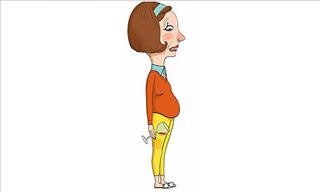Not all sagging stomachs are the same. They come in different shapes and sizes and appear for all sorts of reasons. Sagging stomachs may be caused by alcohol or stress, feeling bloated, thyroid problems and more. Yet while a tummy caused by wine sticks out mainly at the front, a bloated stomach feels hard to touch. The guide below will help you determine what your tummy type is, and how to shrink its size.
1. Wine tummy
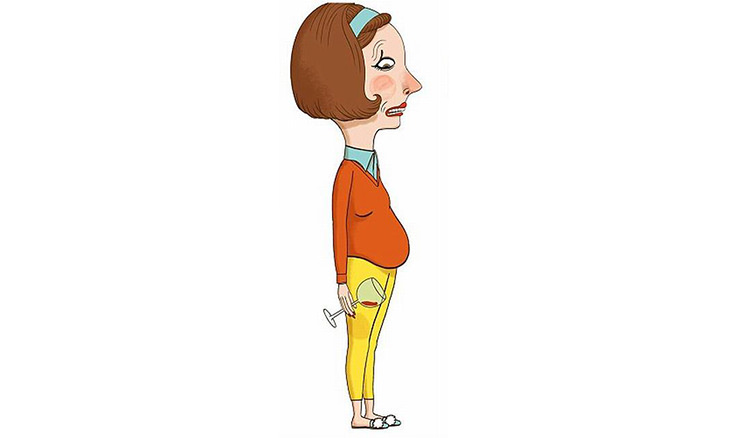
Appearance: While there is less weight gain around your hips and bottom, a wine tummy mainly sticks out at the front. Its appearance resembles that of a pot belly.
The layer of fat stretches from your stomach to your pelvis and may also seep between the vital organs located in this area: the intestines, bowel, and liver. Fat gathers in this area because the fat cells are very sensitive to the effects of insulin (a hormone that dictates how much fat is stored in the body). So, when the sugars from booze are released into the body, insulin is released, telling the body to store it as fat within this deep layer.
Cause: Binge drinking and alcohol. Eating too many refined carbohydrates is also a cause.
Studies show that women who drink more than 12 units in a single sitting gain an extra 4 inches around their waist. In another study conducted on 57,000 people by the Center for Alcohol Research in Denmark, heavier drinkers are more likely to develop a rounded, apple-shaped tummy than those who drink in moderation.
Shed the weight: Watch the calories as you drink.
Alcohol typically slows down metabolism by up to 70%. Generally, this effect does not last long, however, if it becomes a habit, it can make you pack on the pounds, primarily at the waist. Monitor the calories you drink just as much as the ones you eat - doing so may help you resist a third or fourth glass. Bear in mind that a large 250ml glass of wine is equivalent to a 228 calorie ice-cream. Another noteworthy point is that alcohol stimulates appetite, encouraging you to eat more. Consequently, that weight gain will be stored deep inside the body.
2. Bloated tummy
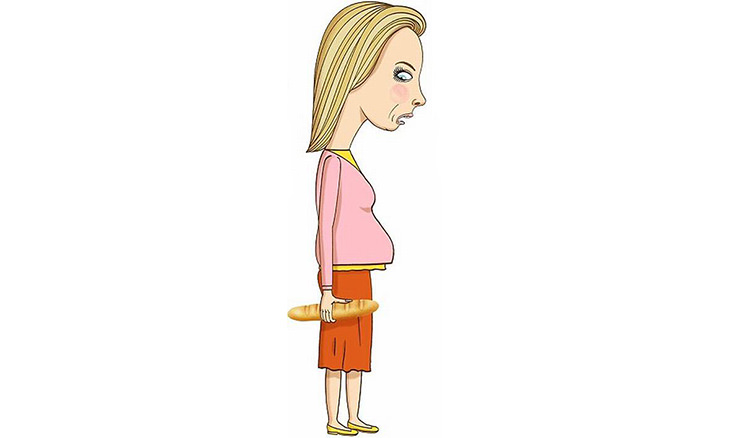
Appearance: A bloated tummy predominantly sticks out at the front. The skin feels hard to touch, almost as if there's an inflated balloon deep inside.
You'll likely start off with a flat tummy at the start of your day, which tends to expand as time goes on, especially after a meal. Nevertheless, no matter how big your tummy gets, your weight will remain the same on the scale.
Cause: A buildup of wind.
Food gets broken down as it travels through the intestines. The bacteria that breaks down the food creates six to eight liters of gas as a by-product. But if the bacteria has difficulty breaking down certain foods, it will start to ferment, creating more wind. Consequently, it starts to push the abdominal wall outwards. Furthermore, constipation and eating too much may also be a cause. And as a result, too much food in the stomach can cause bloating.
Shed the weight: Refrain from eating foods that trigger bloating.
Foods that trigger bloating may be harder for the body to digest, in which case it is best to avoid foods such as artificial sweeteners, wheat, garlic, and onions. Some fruit like cherries and plums, as well as certain vegetables including artichokes, beetroot, and mushrooms, should also be avoided. A lactose-free diet can also help reduce a bloated stomach.
3. Stress tummy

Appearance: If your tummy bulge is caused by stress, it sticks out from the front, but appears softer and has a saggy appearance, more than that of a pot belly.
It tends to start under the bust, forming a soft roll which hangs over your waistband.
Cause: A continuous state of stress.
When we feel stressed, the fight-or-flight hormone known as cortisol releases sugar into the bloodstream, giving the body energy to escape or defend itself. So, unless you use up this energy (as your body is expecting you to), the energy is simply re-deposited as fat.
Shed the weight: Engage in relaxation techniques.
Manage your stress levels with relaxation techniques such as deep breathing and meditation. A good night's sleep is essential as it encourages the body to no longer feel as though it has to prepare for an attack. Eating small portions and slow-release carbohydrates, like oats and legumes, can also help maintain your stress levels.
4. Pear tummy
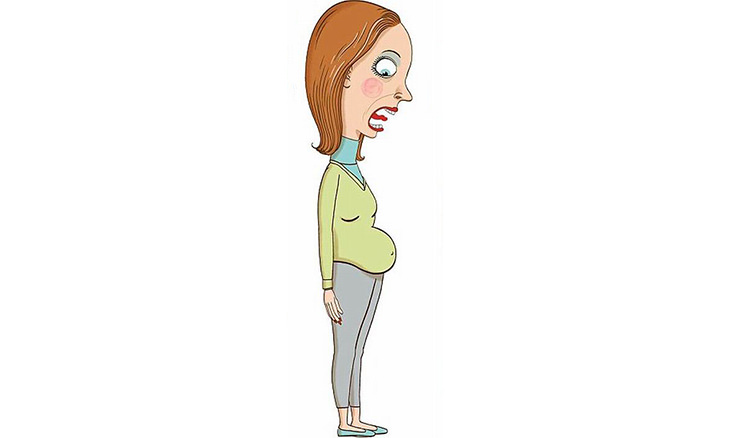
Appearance: A slim waist, with a roll of fat around your bikini line.
Aside from fat around your bikini line, women with a pear tummy generally have a bigger bottom and larger hips, creating a pear-shaped look.
Cause: Female sex hormones, particularly estrogen.
Some women suffer from estrogen dominance, which may be genetic or triggered by other issues causing an imbalance in female sex hormones. It may also be caused by fibroids - benign tumors of muscular tissue which grow inside the womb. Women may also be exposed to too much estrogen because they ingest high levels of synthetic versions of the hormone from farmed meat, water or residues from chemicals in plastics and water. This type of tummy fat is especially common in women aged 30 to 50. Unless a woman is on hormone replacement therapy, she will likely lose the fat on her hips and thighs, leaving her looking more apple-shaped than pear.
Shed the weight: Avoid foods high in saturated fats, which have been linked to higher levels of estrogen.
Opt for a diet high in easy-to-digest fiber, like seeds and green leafy vegetables. These types of food help bind themselves to the extra estrogen in the digestive tract, removing it from the body.
5. Mummy Tummy

Appearance: Your tummy area will lack tone and have a saggy-looking appearance.
A mummy tummy becomes apparent three months or more after you've given birth.
Cause: A weak abdominal wall.
During pregnancy and birth, the abdominal muscles divide, enabling your uterus and tummy to expand. Once you have given birth, the two sides of your six-pack muscles should naturally knit back together. If not, you are left with a bulge. This is caused by a weak abdominal wall, that cannot hold in the contents of your stomach and intestines.
Shed the weight: Seek help from a physiotherapist.
A physiotherapist can teach you exercises to help knit your muscles back in place. Pelvic floor exercises will also help strengthen the muscles from within. Yoga poses, like plank pose, are especially useful.
6. Thyroid tummy
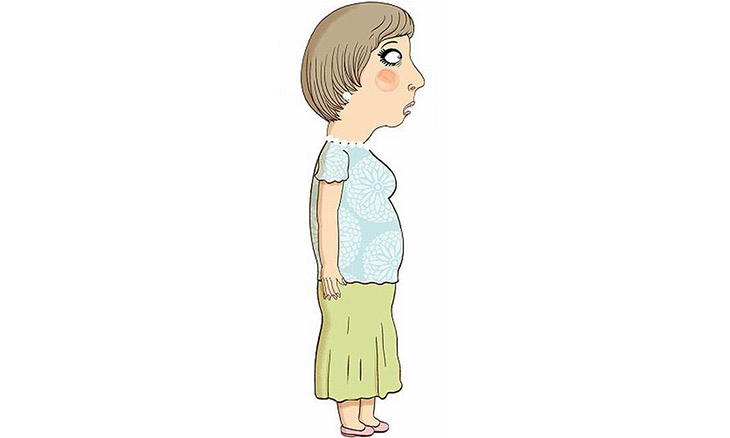
Appearance: Your whole body is big, including your arms and legs.
Cause: Hypothyroidism
A butterfly-shaped gland in the neck produces a hormone called thyroxine, which controls how fast you process calories in food. However, women who suffer from hypothyroidism make less of this hormone. Women who suffer from hypothyroidism do not burn up all the calories consumed, consequently the extra calories are stored, depositing all over the body as fat. Its exact cause is unknown, however, it is believed to be caused by the aging process.
Shed the weight: Eating foods rich in iodine.
Prior to seeking treatment, it is important to get proper diagnosis, as hypothyroidism is often confused with mid-life weight gain. Inadequate levels of thyroxine also cause tiredness, constipation and cold feet - all of which contribute to a slower metabolism. Natural treatment includes eating foods rich in iodine, which help support the thyroid, like shellfish, seafood, and dark leafy green vegetables. Alternatively, treatment may also include drugs containing a synthetic version of the hormone, to top up levels.
Source
 Go to BabaMail
Go to BabaMail


























